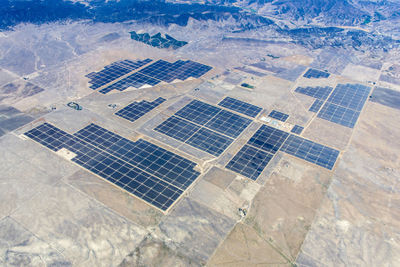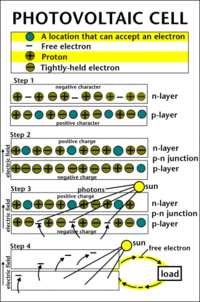Difference between revisions of "Solar Farms in the California Central Coast Region"
(→Existing) |
(→Carrizo Plain Monitoring of Endangered and Threatened Species) |
||
| Line 69: | Line 69: | ||
The [[California Department of Fish and Wildlife (CDFW)]] created the ''Renewable Energy Program'' to facilitate between the state's need for renewable energy and maintenance of natural resources. The Renewable Energy Program enforces compliance and grants permits renegading the [[California Endangered Species Act (CESA)]].<ref>[https://www.wildlife.ca.gov/Conservation/Renewable-Energy CDFW]</ref> | The [[California Department of Fish and Wildlife (CDFW)]] created the ''Renewable Energy Program'' to facilitate between the state's need for renewable energy and maintenance of natural resources. The Renewable Energy Program enforces compliance and grants permits renegading the [[California Endangered Species Act (CESA)]].<ref>[https://www.wildlife.ca.gov/Conservation/Renewable-Energy CDFW]</ref> | ||
====Carrizo Plain Monitoring of Endangered and Threatened Species==== | ====Carrizo Plain Monitoring of Endangered and Threatened Species==== | ||
| + | [[Image: Foxes CarrizoPlain.JPG|350px|thumb|right|San Joaquin kit foxes near a solar farm in the Carrizo Plain. Image: [https://www.fws.gov/sacramento/outreach/featured-stories/RenewableEnergy-CarrizoPlain/RenewableEnergy-CarrizoPlain.htm]]] | ||
| + | |||
On September 2, 2011, the CDFW issued a State Incidental Take Permit (2081-2011-04-04) in response to the presence of San Joaquin kit fox (''Vulpes macrotis mutica'') in the proposed Topaz Solar Farm location. The Incidental Take Permit designated 12,147 acres of "mitigation lands" to serve as habitat for several threatened and endangered species.<ref>[https://www.google.com/url?sa=t&rct=j&q=&esrc=s&source=web&cd=1&cad=rja&uact=8&ved=0ahUKEwjwp6ivr4_TAhVPzGMKHSbsD-EQFggcMAA&url=https%3A%2F%2Fnrm.dfg.ca.gov%2FFileHandler.ashx%3FDocumentID%3D78198&usg=AFQjCNH6xLMwbT4dlAImZfu8QkjdKLO0IA&sig2=Y_ePAOKK22Va4NUjvog-CQ (CDFW) California Department of Fish and Wildlife (US). 2013. Topaz Solar Farm Conservation Lands | On September 2, 2011, the CDFW issued a State Incidental Take Permit (2081-2011-04-04) in response to the presence of San Joaquin kit fox (''Vulpes macrotis mutica'') in the proposed Topaz Solar Farm location. The Incidental Take Permit designated 12,147 acres of "mitigation lands" to serve as habitat for several threatened and endangered species.<ref>[https://www.google.com/url?sa=t&rct=j&q=&esrc=s&source=web&cd=1&cad=rja&uact=8&ved=0ahUKEwjwp6ivr4_TAhVPzGMKHSbsD-EQFggcMAA&url=https%3A%2F%2Fnrm.dfg.ca.gov%2FFileHandler.ashx%3FDocumentID%3D78198&usg=AFQjCNH6xLMwbT4dlAImZfu8QkjdKLO0IA&sig2=Y_ePAOKK22Va4NUjvog-CQ (CDFW) California Department of Fish and Wildlife (US). 2013. Topaz Solar Farm Conservation Lands | ||
| − | Habitat Mitigation and Monitoring Plan. 2013 Annual Report. Fresno: CDFW]</ref> These species | + | Habitat Mitigation and Monitoring Plan. 2013 Annual Report. Fresno: CDFW]</ref> These species included in the report are: |
* San Joaquin Kit Fox (''Vulpes macrotis mutica'') | * San Joaquin Kit Fox (''Vulpes macrotis mutica'') | ||
| Line 81: | Line 83: | ||
* Pronghorn(''Antilocapra americana'') | * Pronghorn(''Antilocapra americana'') | ||
* Tule Elk (''Cervus canadensis nannodes'') | * Tule Elk (''Cervus canadensis nannodes'') | ||
| + | |||
| + | The [[United States Fish and Wildlife Service (USFWS)]] notes that additional species of concern include<ref>[https://www.fws.gov/sacramento/outreach/featured-stories/RenewableEnergy-CarrizoPlain/RenewableEnergy-CarrizoPlain.htm USFWS]</ref>: | ||
| + | |||
| + | * longhorn fairy shrimp (''Branchinecta longiantenna'') | ||
| + | * golden eagle (''Aquila chrysaetos'') | ||
| + | * long-billed curlfew (''Numenius americanus'') | ||
| + | * loggerhead shrike fly (''Lanius ludovicianus'') | ||
| + | |||
| + | There are several more species that could be impacted by solar farms in the Carrizo Plain as it has the highest concentration of threatened and endangered species in the state.<ref>[https://www.nature.org/ourinitiatives/regions/northamerica/unitedstates/california/placesweprotect/carrizo-plain.xml The Nature Conservancy]</ref> | ||
===Land Development=== | ===Land Development=== | ||
Revision as of 01:28, 6 April 2017

This page discusses solar farms in the central coast region.
Contents
Summary
Technology and design

Photovoltaic technology
Solar panels or arrays that converts solar energy directly into electricity implement photovoltaic (PV) technology.
Within each solar panel and array are small units of semiconductor material called PV cells. When sunlight strikes the surface of a PV cell, some photons are absorbed by the semiconductor material.[1] The photons transfer energy into the atoms of the semiconductor material and triggers the release of electrons.[2] These electrons move to the front surface of the PV cell and create an electrical imbalance, with the surface having a more negative charge than the bottom. The imbalance results in a voltage potential similar to the positive and negative ends of a battery.[3] Connecting electrical conductors to the positive and sides of the PV cell creates an electric current and generates electricity.[4]
All existing and proposed solar farms in the central coast use or plant to implement PV technology.
Array Design
Fixed arrays
Fixed arrays are the simplest and most affordable design.[5] These arrays are simply anchored on the ground or surface and remain stationary.
While more affordable, fixed arrays are subject to fluctuations in energy output throughout the day and year. Energy output is maximized when the sun's rays strike the arrays at a perpendicular angle. Since the angle between the arrays and sun changes daily and seasonally, the energy output of fixed arrays is frequently sub-optimal.[6]
Solar trackers
Solar trackers address the shortfalls of fixed arrays. These arrays have motors that allow the panels to follow the sun and increase energy output.
Two types of solar trackers exist: single axis and dual axis. Single axis trackers move in a single direction allowing the tracking of the sun throughout the day. Dual axis trackers add an additional level of moment that allow to follow the sun's position according to time of year.
While the added complexities allow for increased energy output, they are more costly to implement and upkeep.[7]
Locations in the Central Coast Region
Existing
| Name | Location | Date Completed | Acres | Energy capacity | Developer | Technology | Equivalent # of homes powered |
|---|---|---|---|---|---|---|---|
| California Valley Solar Ranch[8] | San Luis Obispo County (Carrizo Plain) | October 2013 | 1500 | 250 MWac | SunPower | Oasis® Power Plant (PV single axis tracking arrays) | 100,000 |
| Topaz Solar Farm[9][10] | San Luis Obispo County (Carrizo Plain) | Novemeber 2014 | 4700 | 550 MWac | First Solar | PV arrays, fixed at 25 degree angle | 160,000 |
Proposed
Impacts
Economic
Scenic
Environmental
Environmental Concerns
Endangered and threatened wildlife
California Department of Fish and Wildlife and Solar Farms
The California Department of Fish and Wildlife (CDFW) created the Renewable Energy Program to facilitate between the state's need for renewable energy and maintenance of natural resources. The Renewable Energy Program enforces compliance and grants permits renegading the California Endangered Species Act (CESA).[11]
Carrizo Plain Monitoring of Endangered and Threatened Species

On September 2, 2011, the CDFW issued a State Incidental Take Permit (2081-2011-04-04) in response to the presence of San Joaquin kit fox (Vulpes macrotis mutica) in the proposed Topaz Solar Farm location. The Incidental Take Permit designated 12,147 acres of "mitigation lands" to serve as habitat for several threatened and endangered species.[12] These species included in the report are:
- San Joaquin Kit Fox (Vulpes macrotis mutica)
- Blunt-nosed Leopard Lizard (Gambelia sila)
- Giant Kangaroo Rat ( Dipodomys ingens)
- Listed Fairy Shrimp (Branchinecta lynchi)
- Nelson’s Antelope Squirrel (Ammospermophilus nelsoni)
- Mountain Plover (Charadrius montanus)
- Burrowing Owl ( Athene cunicularia)
- Pronghorn(Antilocapra americana)
- Tule Elk (Cervus canadensis nannodes)
The United States Fish and Wildlife Service (USFWS) notes that additional species of concern include[13]:
- longhorn fairy shrimp (Branchinecta longiantenna)
- golden eagle (Aquila chrysaetos)
- long-billed curlfew (Numenius americanus)
- loggerhead shrike fly (Lanius ludovicianus)
There are several more species that could be impacted by solar farms in the Carrizo Plain as it has the highest concentration of threatened and endangered species in the state.[14]
Land Development
References
- ↑ U.S. Energy Information Administration
- ↑ Alternate Energy Tutorials
- ↑ U.S. Energy Information Administration
- ↑ NASA
- ↑ Solar Panel Tilt
- ↑ Community energy development co-operative
- ↑ Community energy development co-operative
- ↑ SunPower
- ↑ First Solar
- ↑ BHE Renewables
- ↑ CDFW
- ↑ [https://www.google.com/url?sa=t&rct=j&q=&esrc=s&source=web&cd=1&cad=rja&uact=8&ved=0ahUKEwjwp6ivr4_TAhVPzGMKHSbsD-EQFggcMAA&url=https%3A%2F%2Fnrm.dfg.ca.gov%2FFileHandler.ashx%3FDocumentID%3D78198&usg=AFQjCNH6xLMwbT4dlAImZfu8QkjdKLO0IA&sig2=Y_ePAOKK22Va4NUjvog-CQ (CDFW) California Department of Fish and Wildlife (US). 2013. Topaz Solar Farm Conservation Lands Habitat Mitigation and Monitoring Plan. 2013 Annual Report. Fresno: CDFW]
- ↑ USFWS
- ↑ The Nature Conservancy
Links
Disclaimer
This page may contain student work completed as part of assigned coursework. It may not be accurate. It does not necessary reflect the opinion or policy of [CSUMB], its staff, or students.